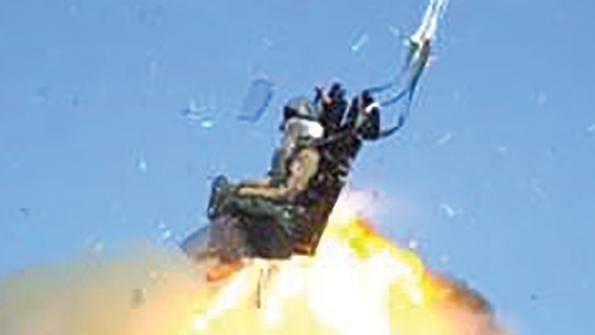
Protracted testing of the ACES 5 ejection seat due to safety concerns contributed to a 2.5-year delay to the T-7A program.
The decision to install an advanced ejection seat in the U.S. Air Force T-7A Red Hawk has caused a 2.5-year delay in standing up the first squadron and contributed to Boeing’s $1.14 billion in losses to date on the fixed-price contract.
As the service struggles to keep a half-century-old fleet of Northrop T-38 Talons flying amid a pilot shortage nearing crisis levels, the question is whether the T-7A program’s problems have been resolved—or have only just started.
- The service expanded the pilot weight range for the seat
- Latest tests posture the T-7A to help spot software glitches
The Air Force is optimistic that Boeing and ejection seat manufacturer Collins Aerospace have resolved the safety concerns about the Advanced Concept Ejection Seat (ACES) 5, the latest version of the ACES II system installed on nearly all other Air Force fighters and bombers except the Lockheed Martin F-35.
Collins completed a sled test of the ACES 5 in February—the last in an unexpectedly long 17-month series for the system—and the first Air Force-owned test aircraft is expected to start taxi tests in several weeks, with a critical decision on a military flight release certification for the T-7A anticipated by the end of May.
“These tests posture the T-7 program to resolve issues with the escape system and move forward to deliver the training capability the Air Force requires,” an Air Force spokesperson said.
But the damage to the program’s schedule has been done. Instead of achieving initial operational capability by the end of October 2024, the Air Force now expects the T-7A to be ready to start training the Air Force’s next fighter and bomber pilots in the spring of 2027. If the latest schedule holds, the T-7A will enter service more than 8.5 years after Boeing’s new aircraft design defeated two more mature aircraft—the Lockheed Martin T-50A and Leonardo T-100—in the contest for a $9.2 billion contract to deliver 351 T-7As and 46 simulators.
The extended timeline stands in contrast to Boeing’s promises about the potential for digital engineering practices to accelerate new aircraft production dramatically.
To be sure, the digital engineering process appears to have worked. Boeing’s T-7A Red Hawk trainer has nearly the length and wingspan of a front-line fighter such as a Lockheed Martin F-16C/D or Saab JAS-39C/D Gripen but takes one-fifth of the time to assemble, Air Force and Boeing officials say. The first Boeing-owned prototype flew within 36 months of concept definition, or roughly half the normal time.
In short, other problems seem to be at the root of the 2.5-year delay.
Although the T-7A appears to be the Air Force’s fleetwide pathfinder for the ACES 5, no ejection seat supplier has been named yet for the Northrop Grumman B-21 Raider.
Goodrich, now part of Raytheon-owned Collins Aerospace, designed ACES II to accommodate pilots weighing 140-211 lb. But the Air Force expanded the weight range for the T-7A to support pilots weighing 103-245 lb. By contrast, the F-35 program office barred pilots weighing less than 136 lb. until Martin-Baker completed modifications to the US-16 ejection seat in 2017, which significantly reduced the risk of injuries from an ejection by pilots with lighter weights.
For the ACES 5 seat, Collins integrated more advanced features, such as a faster-deploying drogue parachute and a rocket motor that adjusts thrust level and pitch based on pilot weight and aerodynamic effects.
As sled testing of ACES 5 began in January 2021, Collins expected to reach certification after a series of 10 tests costing $250,000 each, a November report by the RAND think tank states. But testing showed the ejection seats failed to meet minimum safety standards, according to a fiscal 2022 annual report from the Office of the Director for Operational Test and Evaluation.
The safety concerns delayed the start of T-7A flying by Air Force test pilots, even though Boeing had completed the first Air Force-owned test aircraft in April 2022.
The start of flight testing possibly in midsummer will mark another key milestone. With an aircraft dedicated to training student pilots with as few as 100 hr. in the cockpit, Air Force test pilots will be focused on identifying software bugs in the flight control system so they can be fixed before the T-7A is released into operational service.
Editor's note: This article was updated to correct the weight limitation set by the F-35 program office until Martin-Baker completed modifications to the US-16 ejection seat in 2017.




Comments